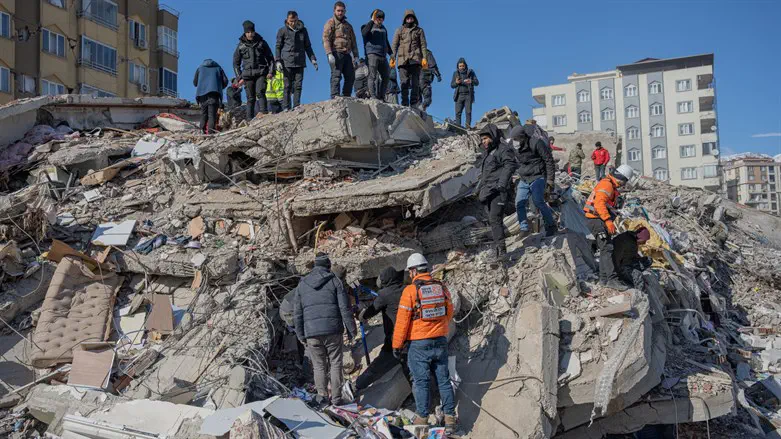
The Israel State Comptroller, Matanyahu Englman, released a special report about local authorities' earthquake preparedness on Tuesday.
The report also dealt with the development of vaccination and immunization for the Covid-19 virus at the Biological Research Institute and even with special aid to the tourism sector during the Covid crisis.
Regarding earthquakes, the comptroller said that "the reminder that we received from the earthquake in Turkey needs to shake the foundations of the government. The data, according to which the Construction and Housing Ministry did not finish reinforcing 93% of the structures that require immediate fortification in the cities in the periphery, and 70% of schools that need to be fortified have yet to be needed to keep the Prime Minister and the ministers awake at night.
The deficiencies are even less understood given the fact that for 2.3 billion NIS, the problems of the cities that are on the Great Rift Valley can be solved. Instead of waiting for an inquiry commission after the tragedy happens, the deficiencies must be fixed immediately."
Local council earthquake preparedness
According to the comptroller, the state of Israel is located on the Great Rift Valley, and therefore the chance of a strong earthquake is high. The accepted assumption is that there is a strong chance that within 50 years, a major earthquake will occur somewhere between southern Lebanon and the southern Dead Sea.
This report, in addition to past reports by the comptroller that dealt with earthquake preparedness in Israel, shows a multi-annual failure in the state's preparation for earthquakes, especially in periphery cities located along the Great Rift Valley. The report's findings emphasize the necessity of work, which includes foresight to improve the state's preparedness for a strong earthquake.
At the beginning of February 2023, Israel received a shocking reminder of the damaging consequences that can hit Israel during a strong earthquake when such a strong earthquake, which was centered in southern Turkey at the northern end of the Great Rift Valley, caused the deaths of tens of thousands of people and tens of thousands of more injuries, the collapse of over 12,000 structures, and over 500,000 people who were left homeless. Since those earthquakes, our area has continued to be hit by quakes that are felt well in Israel.
The report shows that during the time of the inspection, 1,124 (93%) structures that required fortification were not fortified in the towns of Beit Shean, Tiberius, Tzfat, and Kiryat Shemona and the local council of Hatzor Haglilit, the price of which, with the addition of protection, would be 2.34 billion NIS. In addition, regarding the application of the national project for fortifying buildings (TMA 38) in the periphery, the report shows that the program was not implemented in Beit Shean, Tiberius, Tzfat, Kiryat Shemona, and Hatzor Haglilit, although they are all in areas that are prone to be badly harmed by an earthquake and although TMA 38 was the main program to implement the government's policy to reinforce buildings. This is because it is based on an economic model that implementation raises property values in areas where the land value is high.
In addition, the inspection also found that 38 of 54 schools (approximately 70%) that were in need of fortification have yet to be reinforced.
The report also mentions inspections by IDF Homefront Command that showed that the preparedness of the Beit Shean municipality and the Hatzor Haglilit local council is at a low level, the preparedness of the Tiberius and Tzfat municipalities is at a high level, and only the Kiryat Shemona municipality was at a very high level of preparedness. The report shows that there is no obligatory standard regarding emergency equipment that the municipalities have to keep in their emergency storage rooms as part of a disaster preparation plan.
In the presence of international experience that shows that early investment into earthquake preparedness exceptionally lowers mortal harm and property damage, the best way to minimalize damage and prevent a tragedy caused by an earthquake is to improve the structural integrity of residential and public buildings and infrastructure.
Comptroller Engleman emphasizes that the Prime Minister, Defense Minister, Construction and Housing Minister, Interior Minister, and Finance Minister, as well as the inter-ministerial council for earthquake preparedness, must work to promote Israel and the local council's earthquake preparedness, especially in the peripheral localities that are located on the Great Rift Valley.
The comptroller also suggests that the relevant government ministries work together with the Beit Shean, Tiberius, Tzfat, and Kirat Shemona municipalities and the Hatzor Haglilit local council, local councils that are located on the Great Rift Valley, to form a mechanism to reinforce buildings and to find the needed resources. In consideration of the funding needed to reinforce the buildings and infrastructure in the periphery that are mostly on a low socio-economic standing, the project entails all of the professional authorities to enlist and the budgeting of the acceptable funds.
The comptroller concluded the report by suggesting that the state and local governments work quickly to deal with the issue.
